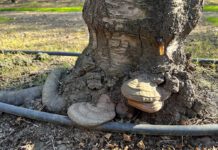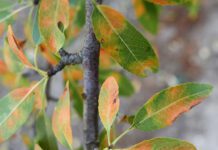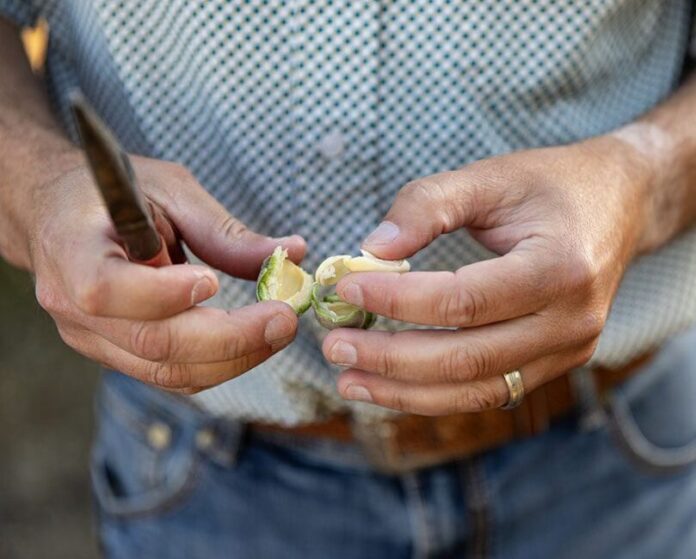
When weather conditions are right, fungal diseases can devastate yields in almond, pistachio and walnut orchards.
A growers’ typical plan is to apply a fungicide at the right time to prevent fungal diseases from affecting crop yields. Several fungicide applications may be needed to lower disease pressure, and that is where the rub is: Using the same chemical fungicide products over time increases the chance the fungal pathogens will develop resistance to the chemistries used.
UC researchers have always cautioned that fungicide products with different modes of action need to be rotated to prevent resistance from developing. That practice is becoming more difficult as fewer new chemistries are being developed and more restrictions are being placed on applications as well as markets that are less friendly to chemical applications. Enter biofungicides.
A Fit for Biofungicides
Biofungicides are made from beneficial organisms: fungi, bacteria and actinobacteria that are commonly found in nature. Biofungicides work to suppress fungal pathogens in several different ways. They can be direct competition to fungal pathogens and exclude them, forming a protective barrier. They can outcompete plant pathogens for infection sites or space. A biofungicide product can also stimulate a plant’s natural defense mechanisms to prevent fungal disease.
“They fit really well in an integrated pest management program,” said Brooks Craven, branded products territory manager with Wilbur Ellis, distributor of the biofungicide Romeo CA.
Craven said a biofungicide can be part of an effective IPM program as a tool to reduce resistance development in fungal pathogens.
“We are still learning about how these products work, which ones will out-compete fungal pathogens. It will depend on the biofungicide product, but feel they are a viable option for growers.”
Most biofungicides are preventative, meaning they must be applied before disease outbreaks, while some may have some curative power. Craven said it is important growers or PCAs be aware of how a biofungicide product works and understand limitations and timing of application. Understanding an orchard’s disease history and environmental conditions are also important components of biofungicide use.
Growers may also look to biofungicides as a tool for zero-day postharvest intervals and avoiding MRL issues with export crops.
Reasons to Consider
Tree nut growers are considering biofungicide use in their orchard for a couple reasons, Josette Lewis, Almond Board of California’s (ABC) chief scientific officer, explained. As more restrictions are placed on conventional pesticide use and fewer new products to combat disease are coming into the market, growers are looking at biofungicides as a part of their pest management practices. Market pressure is playing a part in grower movement to sustainable practices, and a biofungicide fits into that category.
This isn’t to say growers are making major changes in the use of fungicide products. Lewis said growers want to know that biofungicides work and if they are compatible with other pest and disease control products and application timings.
“We need to know the best use of these products, what environmental conditions call for applications, spray timing and even just how fast the spray rig should travel down the row,” Lewis said.
“Growers and pest control advisors need to understand how these products work, best application practices and how to integrate them into a conventional program.”
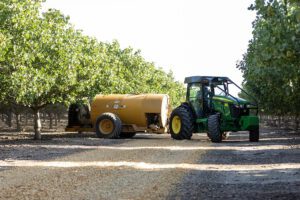
Third-Party Trials on Biofungicides in Tree Nuts
To answer some of these questions and give growers and PCAs confidence in making decisions on biofungicide use, ABC is conducting third-party, multi-year trials on biofungicides with the goal of making the results available to the industry.
The goal of the trial, said Lauren Fann, ABC’s senior specialist in pest management, is to test the efficacy of biopesticide products currently on the market and registered for use in almond. The trial will first evaluate biofungicides and their effectiveness in controlling common almond diseases (brown rot (Monilinia laxa), jacket rot (Botrytis cinerea), hull rot (Rhizopus, Monilinia, Aspergillus and Phomopsis), alternaria (Alternaria alternata) and rust) through replicated trials across the Central Valley. The data collected in 2024 will be used to gain grower buy-in, with the aim of scaling up the trials in 2025 to evaluate the integration of promising biopesticides into current grower disease management practices.
Fann noted with changes in regulations on conventional chemical use always on the horizon, growers may become more reliant on biopesticides to control diseases or insect pests. There can be grower and PCA concerns about the credibility of these bioproducts and their manufacturers, Fann said. While some biopesticides may show promising results for one disease, they may not be as effective for others. In contrast, she added, conventional pesticide products often manage a suite of diseases effectively.
Fann said the ABC trial is designed to gain knowledge about using biofungicides and if there is success to build confidence in products that work for multiple diseases. Many unknowns remain about bioproducts and how well they can be integrated into current pest management practices, she said, so this trial provides an opportunity to learn throughout its duration.
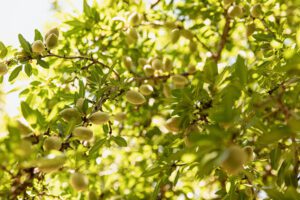
This is the first year of the trial, and the focus is on the efficacy of products in managing diseases in almond. Currently, ABC cannot provide specific guidance on using biofungicides beyond following the product label directions, as one year of data is insufficient. Fann said additional replication across multiple years is necessary to offer more concrete information.
“For the upcoming year, we are working with the individuals running the trials and collaborating with participating companies to gain insights on the best way to integrate these products into the grower standard trials next year.”
Lewis noted because biofungicides do not work like conventional fungicides, the way they work may be more nuanced.
The trial will provide more information about biofungicide use and efficacy.
There is somewhat of a stigma associated with ‘bio’ products, Craven said, with the thinking that they may not be as good as conventional chemistries and cost more.
“There is a range of prices for biofungicide products,” Craven said. “The costs will depend on the specific products, with the ones for organic production in the higher range.
“The thing to keep in mind is they are environmentally friendly, and they play a part in preventing resistance development.”

Cecilia Parsons | Associate Editor
Cecilia Parsons has lived in the Central Valley community of Ducor since 1976, covering agriculture for numerous agricultural publications over the years. She has found and nurtured many wonderful and helpful contacts in the ag community, including the UCCE advisors, allowing for news coverage that focuses on the basics of food production.
She is always on the search for new ag topics that can help growers and processors in the San Joaquin Valley improve their bottom line.
In her free time, Cecilia rides her horse, Holly in ranch versatility shows and raises registered Shetland sheep which she exhibits at county and state fairs during the summer.







